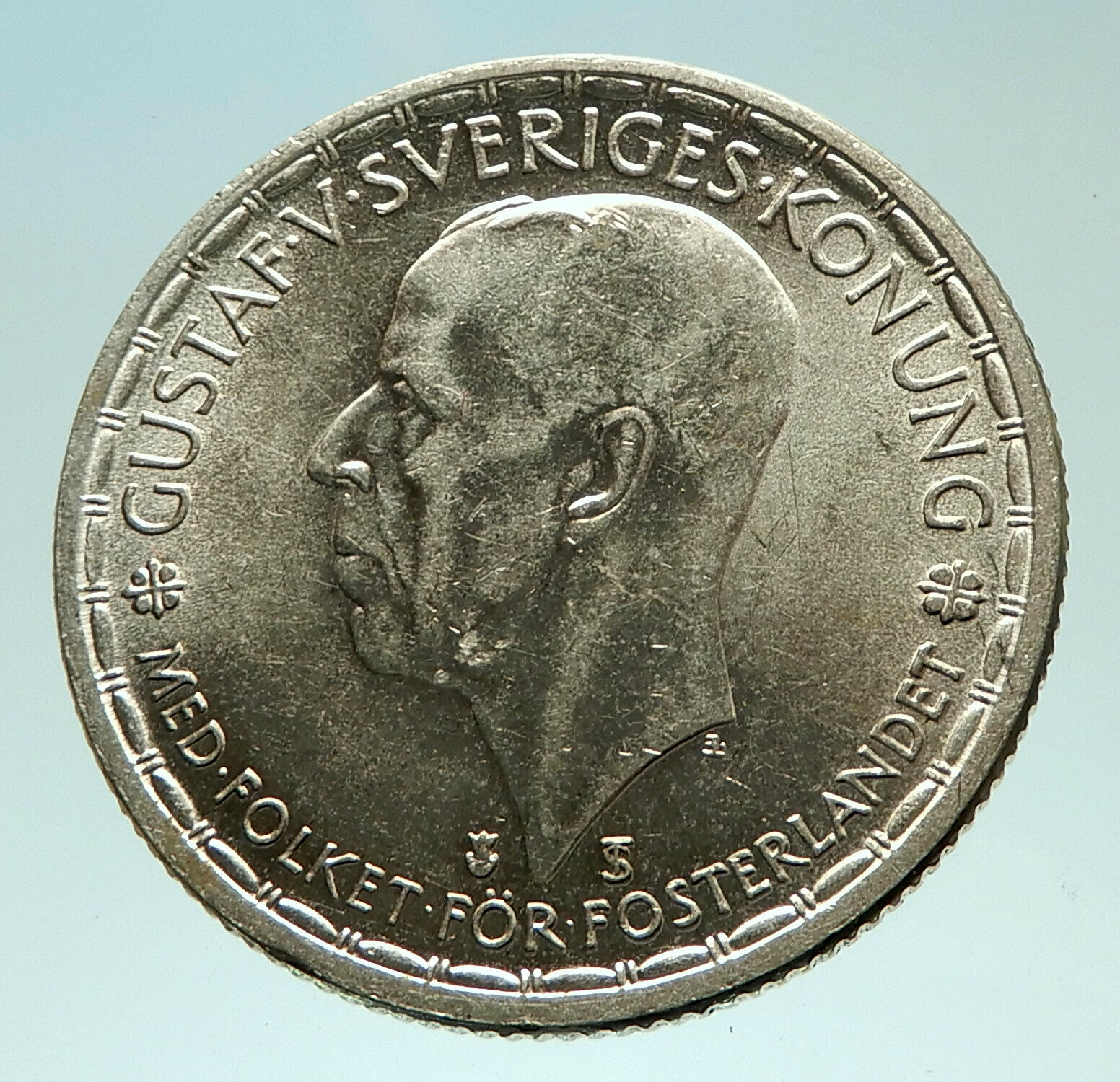|
Russia
Ivan IV, the Terrible
– Tzar: 16 January
1547 – 28 March 1584
Silver Wire Kopek 12mm (0.44 grams)
Horseman galloping right with spear.
You are bidding on the exact item pictured,
provided with a Certificate of Authenticity and Lifetime Guarantee of
Authenticity.

Ivan
IV Vasilyevich, commonly known as Ivan the Terrible, was the
Grand Prince of Moscow
from 1533 to 1547 and
Tsar of All the Russias
from 1547 until his
death. His long reign saw the conquest of the
Khanates of Kazan
,
Astrakhan
, and
Siberia
, transforming Russia into a
multiethnic
and multiconfessional state
spanning almost one billion acres, approximately 4,046,856 km2
(1,562,500 sq mi). Ivan managed countless changes in the progression from a
medieval
state
to an
empire
and emerging
regional power
, and became the first ruler to
be crowned as Tsar of All the Russians.
Historic sources present disparate accounts of Ivan’s complex personality: he
was described as intelligent and devout, yet given to rages and prone to
episodic outbreaks of
mental illness
that increased with his age,
affecting his reign In one such outburst, he killed his groomed and chosen heir
Ivan Ivanovich
. This left the Tsardom to be
passed to Ivan’s younger son, the weak and
intellectually disabled
Feodor Ivanovich
. Ivan’s legacy is complex: he
was an able diplomat, a patron of arts and trade, founder of Russia’s
first Print Yard
, a leader highly popular among
the
common people
of Russia, but he is also
remembered for his
paranoia
and arguably harsh treatment of the
nobility
. The
Massacre of Novgorod
is regarded as one of the
demonstrations of his mental instability and brutality.
Sobriquet
The English word terrible is usually used to translate the Russian
word grozny in Ivan’s nickname, but the modern English usage of terrible,
with a pejorative connotation of bad or evil, does not precisely represent the
intended meaning. The meaning of grozny is closer to the original usage
of terrible—inspiring fear or terror, dangerous (as in
Old English
in one’s danger),
formidable or threatening, tough, strict,
authoritative.
V. Dal
defines grozny specifically in
archaic usage and as an epithet for tsars: “courageous, magnificent,
magisterial, and keeping enemies in fear, but people in obedience“.[8]
Other translations were also suggested by modern scholars.[9][10][11]
Early life
Ivan was the son of
Vasili III
and his second wife,
Elena Glinskaya
, who was half-Serbian
half-Russian.
When Ivan was three years old, his father died from a
boil and inflammation on his leg which developed into
blood poisoning
. Ivan was proclaimed the
Grand Prince of Moscow
at his father’s request.
At first, his mother
Elena Glinskaya
acted as
regent
, but she died of what many believe to be
assassination by poison[12][13]
when Ivan was only eight years old. According to his own letters, Ivan, along
with his younger brother
Yuri
, often felt neglected and offended by the
mighty boyars
from the
Shuisky
and
Belsky
families.
Ivan was crowned with
Monomakh’s Cap
at the
Cathedral of the Dormition
at age 16 on 16
January 1547. He was the first person to be crowned as “Tsar of
All the Russias
“, hence claiming the ancestry
of
Kievan Rus
. Prior to that, rulers of Muscovy
were crowned as Grand Princes, although
Ivan III the Great
, his grandfather, styled
himself “tsar” in his correspondence.
By being crowned Tsar, Ivan was sending a message to the world and to Russia:
he was now the one and only supreme ruler of the country, and his will was not
to be questioned. “The new title symbolized an assumption of powers equivalent
and parallel to those held by former Byzantine Emperor and the Tatar Khan, both
known in Russian sources as Tsar. The political effect was to elevate Ivan’s
position.”[14]
The new title not only secured the throne, but it also granted Ivan a new
dimension of power, one intimately tied to religion. He was now a “divine”
leader appointed to enact God’s will, “church texts described Old Testament
kings as ‘Tsars’ and Christ as the Heavenly Tsar.”[15]
The newly appointed title was then passed on from generation to generation,
“succeeding Muscovite rulers…benefited from the divine nature of the power of
the Russian monarch…crystallized during Ivan’s reign.”[16]
Domestic policy
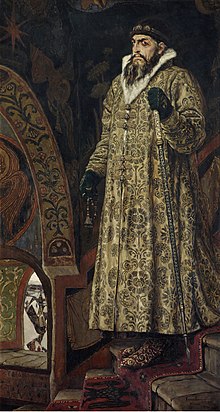
Portrait of Ivan IV by
Viktor Vasnetsov
, 1897 (Tretyakov
Gallery, Moscow)
Despite calamities triggered by the
Great Fire of 1547
, the early part of Ivan’s
reign was one of peaceful reforms and modernization. Ivan revised the law code,
creating the
Sudebnik of 1550
, founded a
standing army
(the
streltsy
),[17]
established the
Zemsky Sobor
(the first Russian parliament of
the feudal Estates type) and the council of the nobles (known as the Chosen
Council), and confirmed the position of the Church with the
Council of the Hundred Chapters
, which unified
the rituals and ecclesiastical regulations of the whole country. He introduced
local self-government to rural regions, mainly in the northeast of Russia,
populated by the state peasantry.
By Ivan’s order in 1553 the
Moscow Print Yard
was established and the first
printing press
was introduced to Russia. The
1550s and 1560s saw the printing of several religious books in Russian. The new
technology provoked discontent with traditional
scribes
, which led to the Print Yard being
burned in an arson attack and the first Russian printers
Ivan Fedorov
and
Pyotr Mstislavets
being forced to flee from
Moscow to the
Grand Duchy of Lithuania
. Nevertheless,
printing of books resumed from 1568 onwards, with Andronik Timofeevich Nevezha
and his son Ivan now heading the Print Yard.
Ivan had
St. Basil’s Cathedral
constructed in Moscow to
commemorate the seizure of
Kazan
. Legend has it that he was so impressed
with the structure that he had the architect,
Postnik Yakovlev
, blinded so that he could
never design anything as beautiful again. In reality, Postnik Yakovlev went on
to design more churches for Ivan and Kazan’s Kremlin walls in the early 1560s,
as well as the chapel over St. Basil’s grave that was added to St. Basil’s
Cathedral in 1588, several years after Ivan’s death. Although more than one
architect was associated with this name and constructions, it is believed that
the principal architect is one and the same person.[18][19][20]
Other events of this period include the introduction of the first laws
restricting the mobility of the
peasants
, which would eventually lead to
serfdom
.
Oprichnina
Main article:
Oprichnina
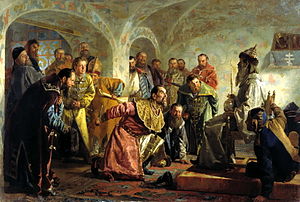
The Oprichniki by
Nikolai Nevrev
. The painting shows
the last minutes of boyarin Feodorov, arrested for treason. To mock
his alleged ambitions on the Tsar’s title, the nobleman was given
Tsar’s
regalia
before execution.
The 1560s brought hardships to Russia that led to dramatic change of Ivan’s
policies. Russia was devastated by a combination of drought and famine,
unsuccessful wars against
Polish-Lithuanian
Commonwealth,
Tatar invasions
and the sea-trading blockade
carried out by the Swedes, Poles and the
Hanseatic League
. His first wife,
Anastasia Romanovna
, died in 1560, and her
death was suspected to be a
poisoning
. This personal tragedy deeply hurt
Ivan and is thought to have affected his personality, if not his mental health.
At the same time, one of Ivan’s advisors, Prince
Andrei Kurbsky
, defected to the Lithuanians,
took command of the Lithuanian troops and devastated the Russian region of
Velikiye Luki
. The series of treasons made Ivan
paranoically suspicious of nobility.
On December 3, 1564, Ivan departed Moscow for
Aleksandrova Sloboda
. From there he sent two
letters in which he announced his
abdication
because of the alleged
embezzlement
and
treason
of the aristocracy and clergy. The
boyar court was unable to rule in Ivan’s absence and feared the wrath of the
Muscovite citizenry. A boyar envoy departed for Aleksandrova Sloboda to beg Ivan
to return to the throne.[21]
Ivan agreed to return on
condition of being granted absolute power
. He
demanded that he should be able to execute and confiscate the estates of
traitors without interference from the boyar council or church. Upon this, Ivan
decreed the creation of the oprichnina.[22]
The oprichnina consisted of a separate territory within the borders of
Russia, mostly in the territory of the former
Novgorod Republic
in the north. Ivan held
exclusive power over the oprichnina territory. The Boyar Council ruled the
zemshchina (‘land’), the second division of the state. Ivan also recruited a
personal guard known as the
oprichniki
. Originally it was a thousand
strong.[23]
The oprichniki were headed by
Malyuta Skuratov
. Known oprichnik was a German
adventurer
Heinrich von Staden
. The oprichniki enjoyed
social and economic privileges under the oprichnina. They owed their allegiance
and status to Ivan, not to heredity or local bonds.[24]
The first wave of persecutions targeted primarily the princely clans of
Russia, notably the influential families of Suzdal’. Ivan executed, exiled, or
forcibly tonsured
prominent members of the boyar clans
on questionable accusations of conspiracy. Among those executed were the
Metropolitan Philip
and the prominent warlord
Alexander Gorbaty-Shuisky
. In 1566 Ivan
extended the oprichnina to eight central districts. Of the 12,000 nobles there,
570 became oprichniks, the rest were expelled.[25]
Under the new political system, the
Oprichniki
were given large estates, but unlike
the previous landlords, could not be held accountable for their actions. These
men, “took virtually all the peasants possessed, forcing them to pay ‘in one
year as much as [they] used to pay in ten.‘“[26]
This degree of oppression resulted in increasing cases of peasants fleeing which
in turn led to a drop in the overall production. The price of grain increased by
a factor of ten.
Sack of Novgorod
Main article:
Massacre of Novgorod
Conditions under Oprichnina were worsened by the 1570 epidemics of plague
that killed 10,000 people in Novgorod. In Moscow it killed 600–1000 daily.[27]
During the grim conditions of the epidemics, famine and ongoing Livonian war,
Ivan grew suspicious that noblemen of the wealthy city of Novgorod were planning
to defect, placing the city itself into the control of the Grand Duchy of
Lithuania. In 1570 Ivan ordered the Oprichniki to raid the city. The Oprichniki
burned and pillaged Novgorod and the surrounding villages, and the city was
never to regain its former prominence.[28]
Casualty figures vary greatly in different sources. The First Pskov Chronicle
estimates the number of victims at 60,000.[28][29][30][30]
Yet the official
death toll
named 1,500 of Novgorod’s big
people (nobility) and mentioned only about the same number of smaller
people.[citation
needed] Many modern researchers estimate the number
of victims to range from 2000–3000 (after the famine and
epidemics
of the 1560s the population of
Novgorod most likely did not exceed 10,000–20,000).[31]
Many survivors were
deported
elsewhere.
Oprichnina did not live long after the sack of Novgorod. During the 1571–1572
Russo-Crimean war
, oprichniks failed to prove
themselves worthy against a regular army. In 1572, Ivan abolished the Oprichnina
and disbanded his oprichniks.
Foreign policy
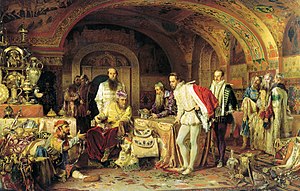
Ivan the Terrible Showing His Treasures to
Jerome Horsey
by
Alexander Litovchenko
(1875)
Diplomacy and trade
In 1547 Hans Schlitte, the
agent
of Ivan, recruited craftsmen in Germany
for work in Russia. However all these craftsmen were arrested in
Lübeck
at the request of Poland and
Livonia
. The German merchant companies ignored
the new port built by Ivan
on the river
Narva
in 1550 and continued to deliver goods in
the Baltic ports owned by Livonia. Russia remained isolated from sea trade.
Ivan established very close ties with
England
. Russo-English relations can be traced
to 1551, when the
Muscovy Company
was formed by
Richard Chancellor
,
Sebastian Cabot
, Sir
Hugh Willoughby
, and several London merchants.
In 1553,
Richard Chancellor
sailed to the
White Sea
and continued overland to Moscow,
where he visited Ivan’s court. Ivan opened up the
White Sea
and the port of
Arkhangelsk
to the Company and granted the
Company privilege of trading throughout his reign without paying the standard
customs fees.[32]
Muscovy Company retained the monopoly in Russo-English trade until 1698.
With the use of English merchants, Ivan engaged in a long correspondence with
Queen Elizabeth
. While the queen focused on
commerce, Ivan was more interested in a military alliance. During his troubled
relations with the boyars, the tsar even asked her for a guarantee to be granted
asylum in England should his rule be jeopardised.
Ivan IV corresponded with Orthodox leaders overseas as well. In response to a
letter of
Patriarch Joachim of Alexandria
asking the Tsar
for financial assistance for the
Saint Catherine’s Monastery
in the
Sinai Peninsula
, which had suffered from the
Turks, Ivan IV sent in 1558 a delegation to
Egypt
by
archdeacon
Gennady, who, however, died in
Constantinople
before he could reach Egypt.
From then on the embassy was headed by
Smolensk
merchant Vasily Poznyakov. Poznyakov’s
delegation visited Alexandria, Cairo and Sinai, brought the patriarch a
fur coat
and an icon sent by the Tsar and left
an interesting account of its 2.5 years of travels.[33]
Conquest of
Kazan and Astrakhan
Main article:
Siege of Kazan (1552)
While Ivan IV was a minor, armies of the
Kazan Khanate
repeatedly raided the northeast
of Russia,[34]
In the 1530s the Crimean khan formed an offensive alliance with
Safa Giray
of
Kazan
, his relative. When Safa Giray invaded
Muscovy
in December 1540, the Russians used
Qasim Tatars
to contain him. After his advance
was stalled near Murom
, Safa Giray was forced to withdraw to his
own borders.
These reverses undermined Safa Giray’s authority in Kazan. A pro-Russian
party, represented by
Shahgali
, gained enough popular support to make
several attempts to take over the Kazan throne. In 1545 Ivan IV mounted an
expedition to the Volga River to show his support for pro-Russian factions.
.jpeg/220px-Siege_of_Kazan_(Pyotr_Korovin,_1890).jpeg)
Ivan IV under the walls of Kazan by Pyotr Korovin
In 1551 the tsar sent his envoy to the
Nogai Horde
and they promised to maintain
neutrality during the impending war. The
Ar begs
and
Udmurts
submitted to Russian authority as well.
In 1551 the wooden fort of
Sviyazhsk
was transported down the Volga from
Uglich
all the way to Kazan. It was used as the
Russian place d’armes during the decisive campaign of 1552.
On 16 June 1552 Ivan IV led a 150,000-strong Russian army towards Kazan. The
last siege of the Tatar capital was commenced on 30 August. Under the
supervision of Prince
Alexander Gorbaty-Shuisky
, the Russians used
ram weapons
, a
battery-tower
,
mines
, and 150 cannons. The Russians also had
the advantage of efficient
military engineers
. The city’s water supply was
blocked and the walls were breached. Kazan finally fell on 2 October, its
fortifications were razed, and much of the population massacred. About 60,000 –
100,000 Russian prisoners and slaves were released. The Tsar celebrated his
victory over Kazan by building several churches with oriental features, most
famously
Saint Basil’s Cathedral
on
Red Square
in Moscow.
Ivan IV before the seizure of Kazan encouraged his army by the examples of
Georgian Queen
Tamar
‘s battles[35]
by describing her as: “The most wise Queen of
Iberia
, endowed with the intelligence and
courage of a man”.[36]
The fall of Kazan had as its primary effect the outright annexation of the
Middle Volga. The
Bashkirs
accepted Ivan IV’s authority two years
later. In 1556 Ivan annexed the
Astrakhan Khanate
and destroyed the largest
slave market
on the river Volga. These
conquests complicated the
migration
of the aggressive
nomadic
hordes from Asia to Europe through
Volga. As a result of the Kazan campaigns, Muscovy was transformed into the
multinational and multi-faith state of Russia.
Russo-Turkish war
Main article:
Russo-Turkish War (1568–1570)
In 1556, the khanate was conquered by Ivan the Terrible, who had a new
fortress built on a steep hill overlooking the Volga. In 1568 the Grand Vizier
Sokollu Mehmet Paşa
, who was the real power in
the administration of the
Ottoman Empire
under
Sultan Selim
, initiated the first encounter
between the
Ottoman Empire
and her future northern rival.
The results presaged the many disasters to come. A plan to unite the Volga and
Don by a canal was detailed in Constantinople and in the summer of 1569 a large
force under
Kasim Paşa
of 1,500
Janissaries
, 2,000
Spakhs
, and few thousand
Azaps
, and
Akıncıs
, were sent to lay siege to
Astrakhan
and begin the canal works, while an
Ottoman fleet besieged Azov
.
Early in 1570, the ambassadors of
Ivan IV of Russia
concluded at
Constantinople
a treaty which restored friendly
relations between the Sultan and the Tsar.
Livonian war
Main article:
Livonian War

Ioannes Basilius Magnus Imperator Russiae, Dux Moscoviae by
Abraham Ortelius
(1574)
![[icon]](https://upload.wikimedia.org/wikipedia/commons/thumb/1/1c/Wiki_letter_w_cropped.svg/20px-Wiki_letter_w_cropped.svg.png)
|
This section requires
expansion
. (January 2012) |
In an attempt to gain access to Baltic sea and its major trade routes, Ivan
launched an ultimately unsuccessful 24 years Livonian war of seaward expansion
to the west and finding himself fighting the
Swedes
,
Lithuanians
,
Poles
and the
Livonian
Teutonic Knights
.
Having rejected peace proposals from his enemies, Ivan IV found himself in a
difficult position by 1579. The displaced refugees fleeing the war compounded
the effects of the simultaneous
drought
, and exacerbated war engendered
epidemics
, causing much loss of life.
Altogether the prolonged war had nearly destroyed the economy, Oprichnina had
thoroughly disrupted the government, while The
Grand Duchy of Lithuania
had
united with
The Kingdom of Poland
and acquired an energetic
leader,
Stefan Batory
, who was supported by Russia’s
southern enemy, the
Ottoman Empire
(1576). Ivan’s realm was now
being squeezed by two of the great powers of the time.
After negotiations with Ivan failed, Batory launched a series of
offensives
against Muscovy in the campaign
seasons of 1579–1581, trying to cut The
Kingdom of Livonia
from Muscovite territories.
During his first offensive in 1579, he retook
Polotsk
with 22,000 men. During the second, in
1580, he took
Velikie Luki
with a 29,000-strong force.
Finally, he began the
Siege of Pskov
in 1581 with a 100,000-strong
army. Narva
in
Estonia
was reconquered by Sweden in 1581.
Unlike Sweden and Poland, Denmark under
Frederick II
had trouble continuing the fight
against Muscovy. He came to an agreement with
John III
of Sweden, in 1580, transferring the
Danish titles of Livonia to him. Muscovy recognized Polish-Lithuanian control of
Livonia only in 1582. After
Magnus von Lyffland
, brother of Fredrick II and
former ally of Ivan, died in 1583, Poland invaded his territories in The
Duchy of Courland
and Frederick II decided to
sell his rights of inheritance. Except for the island of
Saaremaa
, Denmark was out of the
Baltic
by 1585.
Crimean raids
Main articles:
Russo-Crimean Wars
and
Crimean-Nogai raids into East Slavic lands
In the later years of Ivan’s reign, the southern borders of Muscovy were
disturbed by Crimean Tatars. Their main purpose was the capture of
slaves
.[37]
Khan
Devlet I Giray
of
Crimea
repeatedly raided the Moscow region. In
1571, the 40,000-strong Crimean and Turkish army launched a large-scale raid.
Due to the ongoing Livonian war, Moscow’s garrison was as small as 6,000, and
could not even delay the Tatar approach. Unresisted, Devlet devastated
unprotected towns and villages around Moscow and
set Moscow on fire
. Historians estimate the
number of casualties of the fire from 10,000 to as many 80,000 people.
To buy peace from Devlet Giray, Ivan was forced to relinquish his rights on
Astrakhan in favor of Crimean Khanate (although this proposed transfer was only
a diplomatic maneuver and was never actually complete). This defeat angered
Ivan. Upon his orders, between 1571 and 1572 preparations were made. In addition
to
Zasechnaya cherta
, innovative fortifications
were set beyond the river Oka that defined the border.
The following year, Devlet launched another raid on Moscow, now with a
120,000-strong[38]
horde, equipped with cannons and reinforced by Turkish
janissaries
. On July 26, 1572, the horde
crossed the Oka River
near
Serpukhov
, destroyed the Russian vanguard of
200 noblemen and advanced towards Moscow.
The Russian army, led by Prince
Mikhail Vorotynsky
, was half the size,
estimated at between 60,000–70,000 men; yet it was an experienced
streltsi
army, equipped with modern firearms
and gulyay-gorods
. On July 30, the armies clashed
near the
Lopasnya River
in what would be known as the
Battle of Molodi
, which continued for more than
a week. The outcome was decisive Russian victory. The Crimean horde was defeated
so thoroughly that both the
Ottoman Sultan
and the
Crimean khan
, his
vassal
, had to give up their ambitious plans of
northward expansion into
Russia
.
Conquest of Siberia
Main article:
Russian conquest of Siberia
During Ivan’s reign, Russia started a large-scale exploration and
colonization of Siberia. In 1555, shortly after the conquest of Kazan, the
Siberian khan Yadegar and
Nogai
Khan Ismail pledged their allegiance to
Ivan, in hope that he would help them against their opponents. However, Yadegar
failed to gather the full sum of tribute he proposed to the tsar, so Ivan did
nothing to save his inefficient vassal. in 1563 Yadegar was overthrown and
killed by Khan Kuchum
, who denied any tribute to Moscow.
In 1558 Ivan gave the
Stroganov merchant family
the patent for
colonizing “the abundant region along the
Kama River
“, and in 1574, lands over the
Ural Mountains
along the rivers
Tura
and
Tobol
. They also received permission to build
forts along the Ob
and
Irtysh
rivers. Around 1577, the Stroganovs
hired the Cossack leader
Yermak Timofeyevich
to protect their lands from
attacks of the Siberian
Khan
Kuchum
.
In 1580 Yermak started his conquest of Siberia. With some 540
Cossacks
, he started to penetrate territories
that were tributary to Kuchum. Yermak pressured and persuaded the various
family-based tribes to change their loyalties and become tributaries of Russia.
Some agreed voluntarily, under better terms than with Kuchum; others were
forced. He also established distant forts in the newly conquered lands. The
campaign was successful, and the Cossacks managed to defeat the Siberian army in
the
Battle of Chuvash Cape
, but Yermak was still in
need for reinforcements. He sent an envoy to Ivan the Terrible, with a message
that proclaimed Yermak-conquered Siberia a part of Russia, to the dismay of the
Stroganovs, who had planned to keep Siberia for themselves. Ivan agreed to
reinforce the Cossacks with his streltsi. Yermak’s conquest expanded Ivan’s
empire to the east and allowed him to style himself “Tsar of Siberia” in the
tsar’s very last years.
Personal life

Tsar Ivan IV admires his sixth wife
Vasilisa Melentyeva
. 1875 painting
by Grigory Semyonovich Sedov (1836–1886)
Marriages and children
![[icon]](https://upload.wikimedia.org/wikipedia/commons/thumb/1/1c/Wiki_letter_w_cropped.svg/20px-Wiki_letter_w_cropped.svg.png)
|
This section requires
expansion
. (January 2012) |
-
Anastasia Romanovna
(in 1547-1560, death):
- Tsarevna Anna Ivanovna (10 August 1548 – 20 July 1550)
- Tsarevna Maria Ivanovna (17 March 1551 – young)
-
Tsarevich Dmitri Ivanovich
(October
1552 – 26 June 1553)
-
Tsarevich Ivan Ivanovich
(28 March
1554 – 19 November 1581)
- Tsarevna Eudoxia Ivanovna (26 February 1556 – June 1558)
- Tsar
Feodor I of Russia
(31 May 1557 – 6
January 1598)
-
Maria Temryukovna
(in 1561-1569, death):
- Tsarevich Vasili Ivanovich (21 March 1563 – 3 May 1563)
-
Marfa Sobakina
(October 28 – November 13,
1571, death)
-
Anna Koltovskaya
(in 1572, divorce). Last
of his weddings, authorized by the Church
-
Anna Vasilchikova
(in 1575/1576, divorce)
-
Vasilisa Melentyeva
(concubine in 1575 ?).
Possibly 19th-century fake;[39][40][41]
his other “wife”
Maria Dolgorukaya
(1573) is absolutely
fake.[citation
needed]
-
Maria Nagaya
(since 1580):
-
Tsarevich Dmitri Ivanovich
(19 October
1582 – 15 May 1591)

Ivan the Terrible killing his son, detail from a painting by
Ilya Repin
In 1581 Ivan beat his pregnant daughter-in-law for wearing immodest clothing,
and this may have caused a miscarriage. His second son, also named
Ivan
, upon learning of this, engaged in a
heated argument with his father, resulting in Ivan striking his son in the head
with his pointed staff, causing his son’s death.[citation
needed] This event is depicted in the famous
painting by Ilya Repin
, Ivan the Terrible and his son
Ivan on Friday, 16 November 1581 better known as Ivan the Terrible
killing his son.
Arts
Ivan was a poet, a composer of considerable talent, and supported the arts.
His Orthodox liturgical hymn, “Stichiron No. 1 in Honor of St. Peter”, and
fragments of his letters were put into music by Soviet composer
Rodion Shchedrin
. The recording was released in
1988, marking the millennium of Christianity in Russia, and was the first
Soviet-produced CD.[42][43][44]
Epistles
D.S. Mirsky
called Ivan “a pamphleteer of
genius
“.[45]
The
epistles
attributed to him are the masterpieces
of old Russian (perhaps all Russian) political journalism. They may be too full
of texts from the Scriptures and the Fathers, and their
Church Slavonic
is not always correct, but they
are full of cruel irony, expressed in pointedly forcible terms.
The shameless bully and the great
polemicist
are seen together in a flash when he
taunts the runaway prince Kurbsky with the question: “If you are so sure of your
righteousness, why did you run away and not prefer martyrdom at my hands?” Such
strokes were well calculated to drive his correspondent into a rage. “The part
of the cruel tyrant elaborately upbraiding an escaped victim while he continues
torturing
those in his reach may be detestable,
but Ivan plays it with truly
Shakespearian
breadth of imagination”.[46]
These letters are often the only existing source on Ivan’s personality and
provide crucial information on his reign, but
Harvard
professor Edward Keenan has argued that
these letters are 17th century forgeries. This contention, however, has not been
widely accepted, and most other scholars, such as John Fennell and
Ruslan Skrynnikov
continued to argue for their
authenticity. Recent archival discoveries of 16th century copies of the letters
strengthen the argument for their authenticity.[47][48]
Besides his letters to Kurbsky he wrote other satirical invectives to men in
his power. The best is his letter to the abbot of the
Kirillo-Belozersky Monastery
, where he pours
out all the poison of his grim irony on the unascetic life of the boyars, shorn
monks, and those exiled by his order. His picture of their luxurious life in the
citadel of
ascetism
is a masterpiece of trenchant sarcasm.
Death

Death of Ivan the Terrible by
Ivan Bilibin
(1935)
Ivan died from a stroke
while playing
chess
with
Bogdan Belsky
[49]
on 28 March [O.S.
18 March] 1584.[49]
Upon Ivan’s death, the Russian throne was left to his unfit and childless middle
son
Feodor
. Feodor died childless in 1598, ushering
in the
Time of Troubles
.
Legacy

Forensic facial reconstruction of Ivan IV by
Mikhail Gerasimov

Ivan’s throne (ivory, metal, wood)
For centuries after Ivan’s death historians have developed different
hypotheses to better understand his reign, which undeniably changed Russian
history and continues in popular imagination. His political legacy completely
altered the Russian governmental structure; his economic policies ultimately
contributed to the end of the
Rurik Dynasty
, and his social legacy lives on
in unexpected places.
Arguably Ivan’s most important legacy can be found in the political changes
that he enacted in Russia. In the words of historian Alexander Yanov, “Ivan the
Formidable and the origins of the modern Russian political structure [are]…
indissolubly connected.”
[50]
Ivan’s political revolution surpassed the symbolic power of his title by
significantly altering Russia’s political structure. The creation of the
Oprichnina
diminished the power of the boyars
to create a more centralized government. “…the revolution of Tsar Ivan was an
attempt to transform an absolutist political structure into a despotism… the
Oprichnina proved to be not only the starting point, but also the nucleus of
autocracy which determined… the entire subsequent historical process in
Russia.”[51]
Ivan created a way to bypass the
Mestnichestvo
system and elevate the men among
the gentry to positions of power, thus suppressing the aristocracy that failed
to support him.[52]
The structure of local governments was altered to include, “a combination of
centrally appointed and locally elected officials. Despite later modifications,
this form of local administration proved to be functional and durable.”
[16]
Ivan successfully cemented autocracy
and a centralized government and thereby also “a centralized apparatus of
political control in the form of his own guard.”[53]
The idea of a guard as a means of political control became so ingrained in
Russian history that it can be traced to
Peter the Great
,
Vladimir Lenin
, who “… [provided] Russian
autocracy with its Communist incarnation”, and
Joseph Stalin
, who “[placed] the political
police over the party.” Yanov concludes that “Czar Ivan’s monstrous invention
[i.e. the guard] has thus dominated the entire course of Russian history.”[54]
Ivan by expanding into Poland (although a failed campaign), the Caspian and
Siberia established a sphere of influence that lasted until the 20th century.
His conquests ignited a conflict with Turkey that later caused successive wars:
“Russia’s victories confined the Turkish conquests to the Balkans and the Black
sea region, although Turkish expansionism continued to cast a shadow over the
whole of Eastern Europe.”[55]
Acquiring territory enabled another of Ivan’s legacies: a relationship with
Europe, especially through trade. Although contact between Russia and Europe
remained small, it would later grow, facilitating the permeation of European
ideals across the border.
Peter the Great
would later push Russia to
become a European power, and
Catherine II
would manipulate that power to
make Russia a leader within the region.
Contrary to his political legacy, Ivan IV’s economic legacy was disastrous
and contributed to the decline of the
Rurik Dynasty
and the
Time of Troubles
. Ivan inherited a government
in debt, and in an effort to raise more revenue instituted a series of taxes.
“It was the military campaigns themselves… that were responsible for the
increasing government expenses.”[56]
Worse, successive wars drained the country both of men and resources. “Muscovy
from its core, where its centralized political structures depended upon a dying
dynasty, to its frontiers, where its villages stood depopulated and its fields
lay fallow, was on the brink of ruin.”[57]
Ivan’s political revolution also created a centralized government structure,
the ramifications of which extended to local government. “The assumption and
active propaganda of the title of Czar, transgressions and sudden changes in
policy during the Oprichnina contributed to the image of the Muscovite prince as
a ruler accountable only to God.”[16]
Subsequent Russian rulers inherited a system put in place by Ivan.
Another interesting and unexpected aspect of Ivan’s social legacy emerged
within Communist Russia. In an effort to revive Russia nationalist pride, Ivan
the Formidable’s image became closely associated with
Joseph Stalin
.[58]
Historians faced great difficulties when trying to gather information about Ivan
IV in his early years because “Early Soviet historiography, especially in the
1920s, paid little attention to Ivan IV as a statesman.” This paucity however,
was not surprising because “Marxist intellectual tradition attached greater
significance to socio-economic forces than to political history and the role of
individuals.” By the second half of the 1930s, the method used by Soviet
historians changed: they more greatly emphasized the individual, and history
became more “comprehensible and accessible”. The way was clear for an emphasis
on such ‘great men’ as Ivan the Formidable and Peter the Great, who greatly
strengthened and expanded the Russian state. The Soviet Union’s focus on great
leaders would thereafter be greatly exaggerated, driving historians to gather
more and more information on the great Ivan the Formidable.[59]
Today a controversial movement in Russia campaigns in favor of granting
sainthood
to Ivan IV.[60]
The Russian Orthodox Church has stated its opposition to the idea.[61]
Cinema and literature
- The Soviet filmmaker
Sergei Eisenstein
made two films based on
the life of the Great Tsar –
Ivan the Terrible
. The first film is
about the early progressive years of Ivan as a young tsar. The second part
tells us about the cruel period of Ivan’s mature age. A third one was never
completed.
-
Conrad Veidt
portrayed Ivan the Terrible in
Paul Leni
‘s film “Waxworks“.
Tsar
– a 2009 Russian drama film
directed by
Pavel Lungin
.-
Ivan the Terrible in Russian folklore
.
- In the movie
Night at the Museum: Battle of the Smithsonian
Ivan was played by
Christopher Guest
.
Russka
(1991) the novel by
Edward Rutherford
- In the popular
Soviet era
comedy film
Ivan Vasilievich: Back to the Future
featuring the serial character Engineer Shurik,[62]
played by
Aleksandr Demyanenko
, Shurik inadvertently
transports a character named Ivan Vasilevich Bunsha, played by acclaimed
Russian actor
Yury Yakovlev
, to the time of Ivan the
Formidable, also played by Yakovlev. Ivan the Formidable is simultaneously
transported to the
Soviet Union
circa 1973, with Bunsha and
Ivan the Formidable switching places and professions. The switch
consequently results in a farcical tale with comedic hijinks arising, in
large part, from the absurdity of placing the first recognized
Tsar of All Russia
into everyday
20th-century
Soviet
life. The film is based on a play by
Mikhail Bulgakov
and was one of the most
attended movies in the
Soviet Union
in 1973, with more than 60
million tickets sold.[63]
Ancestry
[show]Ancestors
of Ivan the Terrible |
In art
-
Ivan the Terrible meditating at the deathbed of his son.
Ivan’s murder of his son brought about the extinction of the
Rurik Dynasty
and the
Time of Troubles
. Painting by
Vyacheslav Schwarz
(1861).
-
Ivan the Formidable And His Son Ivan, 16 November 1581 by
Ilya Repin
, 1885 (Tretyakov
Gallery, Moscow)
-
Ivan the Terrible, by
Sergei Kirillov
-
Ivan the Terrible by
Klavdiy Lebedev
, 1916
-
Ivan’s repentance: he asks a father superior Kornily of the
Pskovo-Pechorsky Monastery
to let
him take the
tonsure
at his
monastery
. Painting by
Klavdiy Lebedev
, 1898.
-
Ivan the Terrible and his old nanny, by Bogdan (Karl) Venig
-
Ivan the Terrible and souls of his victims, by
Mikhail Clodt
-
Tsar Ivan the Terrible and the priest Sylvester, 24 June, 1547 (oil
painting, 1856, by Pavel Pleshanov)
-
Ivan the Terrible, with the Body of His Son, Who he has Murdered
(1860s), by
Nikolay Shustov
See also
-
Tsars of Russia family tree
-
Tsardom of Russia
History of the Tsardom of
Russia
|















.jpeg/220px-Siege_of_Kazan_(Pyotr_Korovin,_1890).jpeg)

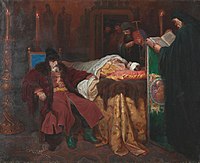

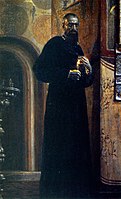


.jpg/149px-Iwan_Groźny_i_jego_niania_(1886).jpg)
.jpg/200px-Ivan_the_Terrible_and_the_souls_of_his_victums_by_M.P.Klodt_(detail).jpg)




